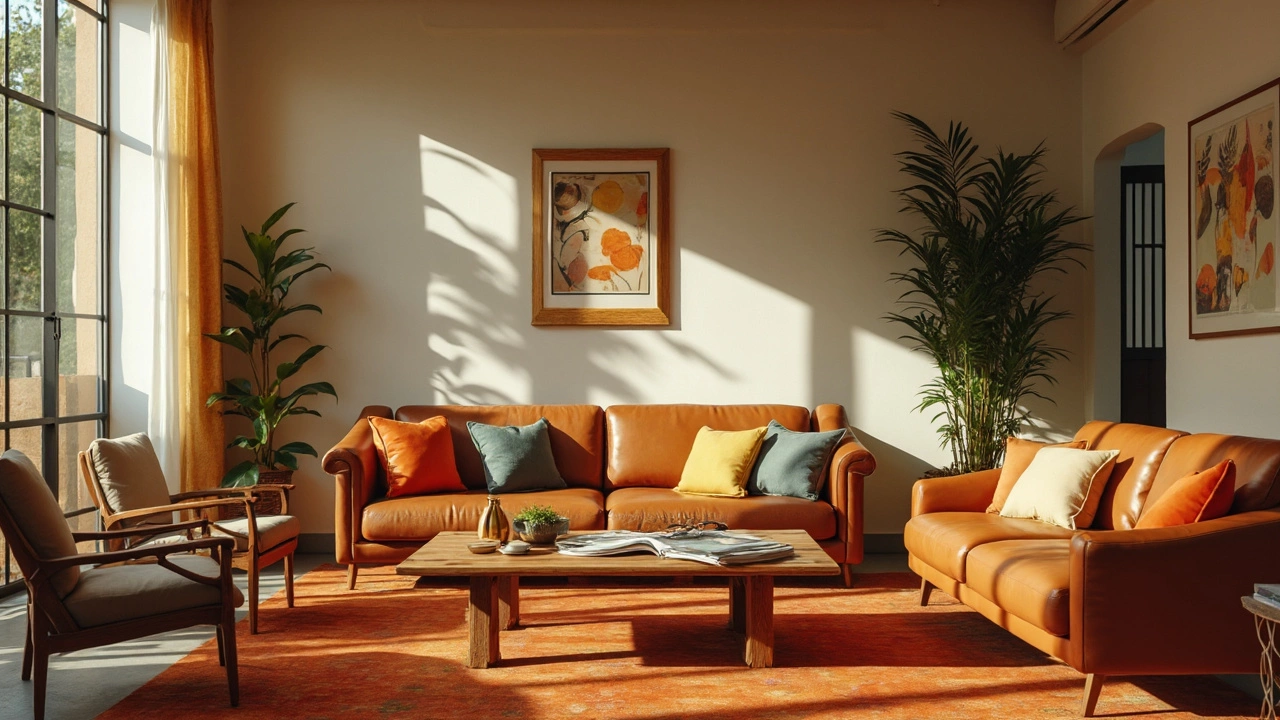Stuck deciding if you should go big on that sleek Italian sofa or stick to your local store? You’re not alone. The furniture world has a surprising divide—some makers go all-in on wild design, while others put every penny into quality that lasts forever. Spoiler alert: price and brand aren’t everything.
So, what really separates legendary furniture from stuff that looks decent for a season but falls apart before you’ve finished paying it off? It usually comes down to three big things: craftsmanship, materials, and design that fits real life. Some makers obsess over the details—they’ll sand the back of a drawer nobody sees, or pick solid wood when everyone else uses veneer. Others? Well, they ride on a fancy logo and slick photos but cut corners everywhere else.
- What Makes Furniture 'The Best'?
- Top Countries for High-Quality Furniture
- Iconic Brands and Their Secrets
- Tips for Buying Furniture That Lasts
What Makes Furniture 'The Best'?
If you ask anyone who's owned both cheap and quality furniture, they’ll tell you—looks are just part of the story. The real gold standard is how something holds up after years of use, not just how it flashes on Instagram on delivery day.
The big three for top-tier furniture makers always come down to craftsmanship, materials, and how a piece actually works in everyday life. Think of it like this: good joinery (like proper dovetails or mortise-and-tenon joints) is a telltale sign you’re dealing with quality. Bad furniture skips this and uses glue, nails, or staples that barely hang on after a couple of moves.
Materials matter too. Genuine solid wood, properly tanned leather, and strong steel hardware can outlast lower-end plywood or thin particleboard by decades. Here’s a real-world example:
| Material | Avg. Lifespan (Years) | Common Use |
|---|---|---|
| Solid Oak | 40+ | Desks, tables |
| Plywood | 10-15 | Cabinets, budget sofas |
| Particleboard | 5-7 | Flat-pack shelves |
But design is where the magic happens. Even the best-built piece stinks if it’s a pain to use—like a couch that looks cool but kills your back. The best sofas or beds nail it on both style and comfort, which is why brands like Vitra and Herman Miller have loyal followings. That’s not a coincidence: people come back because those pieces fit real life without falling apart.
Lastly, pay attention to the little things: do the drawers glide effortlessly, are there loose threads, does the finish feel smooth? When you’re buying the best furniture, these details aren’t extras—they prove the maker actually gives a damn.
Top Countries for High-Quality Furniture
When it comes to best furniture in the world, a few countries pop up again and again. They’re not just making basic stuff—they’re setting the standard for everything from design to durability.
Let’s start with Italy. Italians aren’t just about fast cars and great food; they know furniture like no one else. Think of names like Poltrona Frau or Cassina. These guys use old-school techniques—lots of handwork, real leather, solid wood—and push the envelope on modern style. If you want a statement piece or luxury furniture sale item, Italian brands are tough to beat.
Then there’s Denmark and the rest of Scandinavia. The Danes, especially, lead with clean lines and clever design. “Danish Modern” isn’t just a style—it’s practically a movement. You’ll see designers like Hans Wegner or brands like Carl Hansen & Søn behind so many of those simple yet sturdy chairs and tables. It’s not all looks, either. Scandinavia is huge on sustainability and honest materials, so you get style and a clear conscience.
Germany is another hot spot. German furniture brands—think Rolf Benz or Walter Knoll—mix engineering smarts with real attention to detail. If you want something that comes with ten-year guarantees (and honestly looks ready to survive a tornado), this is your spot.
Of course, the USA has its classics. American makers like Stickley or Herman Miller keep old-school craftsmanship alive but also lead in functional, modern office furniture. American-made pieces, especially in the mid-century style, are getting more popular every year, sometimes costing a small fortune at auctions.
Here’s a quick snapshot of leading furniture countries and their specialties:
| Country | Known For | Popular Brands |
|---|---|---|
| Italy | Luxury, high design, classic craftsmanship | Poltrona Frau, Cassina, B&B Italia |
| Denmark | Modern design, durability, sustainability | Carl Hansen & Søn, Fritz Hansen |
| Germany | Precision engineering, sturdy builds | Rolf Benz, Walter Knoll |
| USA | Classic and modern styles, office innovation | Herman Miller, Stickley, Knoll |
If you’re browsing for quality furniture, also keep an eye on smaller countries like Portugal—they’re making a splash with handmade pieces and affordable style. But if you want brands that have truly earned their reputation, the four above should be your top targets.
Iconic Brands and Their Secrets
When it comes to best furniture, a few names pop up in conversations around the world for a reason. For starters, Italian giants like Poltrona Frau and B&B Italia have their roots in hand-finished leather and modern, functional design—no wonder you see their sofas in celebrity homes and luxury hotels. Poltrona Frau has been making leather armchairs since 1912; you can actually spot their work on Ferrari interiors too. That’s obsession with detail, and real car lovers will nod at that.
Turn to Scandinavia, and everyone’s heard of IKEA, but if you want pieces that last decades, look at brands like Carl Hansen & Søn out of Denmark. They’re famous for the Wishbone Chair—still made by hand, every single piece. It takes over 100 steps to build that thing. Swedish brand Svenskt Tenn is another one to watch if you like bold, unique patterns and craftsmanship.
In the US, Herman Miller leads the charge for modern office and home furniture. It’s not just tech offices snapping up their stuff—Miller’s Aeron chair changed work comfort in the ‘90s and still gets rave reviews today. And don’t sleep on Stickley, an American classic since 1900. Their secret? Solid hardwood and joinery that basically never gives out. They don’t mess with shortcuts, and you feel that in every drawer and panel.
- B&B Italia: Known for high-end sofas and modular systems. Minimalist looks, crazy-durable foam and fabric.
- Carl Hansen & Søn: Home of the Wishbone Chair. Over 100 hand-finishing steps for each chair.
- Herman Miller: Famous for the Aeron chair and mid-century modern pieces. Iconic for blending style and ergonomic comfort.
- Stickley: Traditional American hardwood furniture. Old-school craftsmanship with updated styles.
If you’re looking for stats, here’s an idea of how tough these brands build their products:
| Brand | Average Lifespan | Main Materials | Specialty |
|---|---|---|---|
| Poltrona Frau | 20+ years | Leather, wood | Luxury seating |
| Carl Hansen & Søn | 25+ years | Solid oak, paper cord | Iconic chairs |
| Herman Miller | 15-20 years | Mesh, plastics, aluminum | Ergonomic office chairs |
| Stickley | 30+ years | Hardwood | Classic American furniture |
The real secret? All these furniture makers stick to a simple formula: don’t cut corners, respect the material, and make every piece as if they’ll pass it down to their own family. If you want quality furniture that lasts, these brands actually deliver.
Tips for Buying Furniture That Lasts
When you’re searching for best furniture, it’s easy to get lost in all the talk about style and trends. But if you want stuff that holds up, focus on what’s under the hood—materials, construction, and even the way brands handle warranties.
- Check the materials. Solid wood (like oak, maple, or walnut) beats plywood or particleboard every time. Real leather or high-density fabric also outlasts cheap alternatives. When you see “engineered wood,” ask if it’s anything more than glorified sawdust.
- Test the joints. Dovetail, mortise-and-tenon, or doweled joints give away the good stuff. If you look under a table and see only staples and glue, walk away. Those shortcuts mean it’s not built to last.
- Pay attention to weight. Heavy = quality, most of the time. Good furniture makers use dense, sturdy materials. If you can lift a bookshelf by yourself and it feels like air, it’s probably not great.
- Look for a solid warranty. The top furniture sale brands stand behind what they sell. A 10-year warranty is way better than a quick six months—and it tells you they expect the piece to last that long.
- Read reviews from real owners. Before buying, check out what people say after a year or two. Some brands look perfect in a showroom but start sagging or chipping fast. Honest feedback online can save you from a pricey mistake.
If stats help you decide, here’s something practical: According to a 2023 consumer report, 68% of people who bought solid wood living room furniture were still satisfied after five years, compared to only 39% for those who bought particleboard. Not a small gap.
| Material | Average Lifespan (Years) |
|---|---|
| Solid Wood | 15+ |
| Engineered Wood | 5-7 |
| Metal Frames | 10-12 |
| Plastic | 2-3 |
Bottom line: don’t just chase a trendy label or the first big furniture sale sign you see. Get hands-on, look underneath, and think long-term. You’ll save money—and sanity—in the end.

